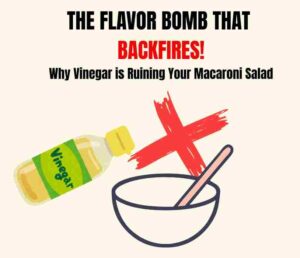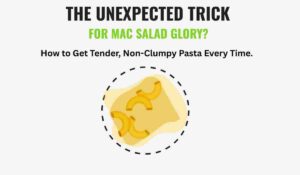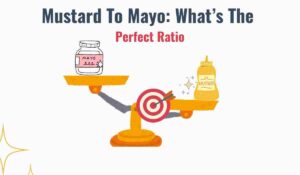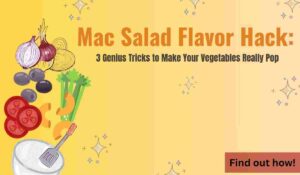Easy Macaroni Salad Without Vinegar
The classic macaroni salad recipe has a major, fundamental flaw: the often-harsh bite of vinegar. As someone obsessed with flavor balance, I consider using vinegar a giant, blinking FLAVOR ERROR. I've proven, through extensive testing, that the most lusciously creamy and flavorful salad is made without vinegar. This isn't just a slight improvement; it's a revolutionary upgrade! I’ll show you exactly how to achieve this superior flavor profile and explain why a vinegar-free macaroni salad is simply BETTER.
Vinegar-Free Macaroni Salad: The Real Reason It Tastes So Much Better Now

Look, I’ve spent enough time developing recipes to know that balance is everything. Vinegar is a strong acid, and it doesn’t play nicely here.
Sweetness Annihilated:
Macaroni salad needs a subtle sweetness. Vinegar doesn’t provide a pleasant sweet-and-sour profile; it provides a harsh, overwhelming “zing.” It utterly annihilates the sweetness. The palate registers the acidity so strongly that all you taste is a dominant, unpleasant sourness. It becomes a true “sour vinegar shockwave.”
Harsh Acidity:
Especially if you use a cheap, strong distilled white vinegar—and let’s be honest, who isn’t reaching for that bottle in a pinch?—the dish becomes aggressively and unpleasantly tangy. I’m telling you, it leaves a puckering, sour sensation that makes the whole dish lively in all the wrong ways!
The Chemistry of Ruin: Texture and Taste
This is where the Baking Nerd in me gets a little cranky, because vinegar isn’t just a flavor issue; it’s a structural one.
Mayonnaise Breakup! The base of our glorious, creamy salad is mayonnaise, which is an oil-in-water emulsion. It’s already acidic! Adding extra vinegar pushes the total acidity too high. You know what happens then? The emulsion destabilizes—it “breaks.” Instead of that beautiful, thick, velvety coating we crave, you’re left with a thin, runny dressing. The rich texture is completely destroyed.
The Salting Spiral: Here’s a tricky one: too much vinegar fights with saltiness. While a tiny bit of acid brightens flavor, an excess makes the dish taste under-seasoned. So, what do you do? You instinctively add more salt just to register the flavor! You end up with a salad that is both overwhelmingly sour and excessively salty. It’s a lose-lose
Muting the Magic :
Great macaroni salad relies on those complex, background notes. Vinegar just shouts over them.
Goodbye, Herbs and Spices: That strong acid just mutes all the subtle, aromatic flavors of the celery, onion, mustard, and spices. They taste dull or indistinct. You put in the work, but the vinegar makes those wonderful flavors vanish!
neutralizing the Umami:
That satisfying richness and umami come from the fats in the mayonnaise and the starches in the pasta. Too much sharp, overpowering acid simply slices through and neutralizes that feeling of richness. You’re left with a salad that feels lean and harsh, NOT creamy and satisfying.
Trust me on this one: Skip the vinegar! The acidity already in your mayonnaise and perhaps a little savory mustard is all you need for the perfect lift without detonating the beautiful balance you’ve worked so hard to create. You’ll thank me when you taste that perfectly balanced, rich, creamy result!
The Science Behind Perfect Macaroni Salad: How to Beat the Sticky Pasta Curse :

You absolutely deserve a macaroni salad that’s nothing short of LEGENDARY, not that pasty, clumpy stuff that tastes like plain, naked pasta! Achieving the BEST flavor and texture in macaroni salad is a science, and honestly, it’s one of my favorite nerdy kitchen puzzles to solve. I’m going to walk you through exactly how we conquer the elbow pasta challenge so your salad is tender, non-clumping, and just BURSTING with flavor.
Why Elbow Pasta is a Mac Salad Villain (and How We Tame It)
You know how sometimes macaroni salad is just…sticky? That’s all thanks to the elbow pasta’s unique, curved design. Those little tubes are basically perfect little starch traps!
The curved shape traps the sticky, released starch right inside its nook. Combined with the high amount of starch it releases while cooking, it makes elbow macaroni the most likely candidate for clumping and stickiness. Plus, when pasta cools, the starch molecules do this thing called retrogradation—they tighten up and expel moisture. This is why chilled pasta can feel dry and rock-hard. We simply CANNOT let that happen.
The Secret to the PERFECT Tender Bite:
I know what you’re thinking: Overcook the pasta? Is she crazy? Hear me out, because this is the single most critical step that separates good macaroni salad from GREAT macaroni salad.
We’re going to use a counter-intuitive technique that guarantees a tender bite, even after chilling. The main villain for cold pasta is that starch retrogradation—it makes the pasta TOUGH. Our solution is to soften the core so much that it has a buffer against that hardening:
- Intentional Tenderizing:
Cook the pasta until it’s VERY TENDER—go about two to three minutes past the package directions. Don’t worry, this isn’t mush. This step is about maximizing water absorption. This moisture buffer maintains a soft, yielding texture and, most importantly, creates a porous structure that’s ready to suck up that delicious dressing.
The Clump-Proof Cooking Protocol
Preventing stickiness is all about starch control. I always tell people you need to treat this like a surgical procedure:
- High-Volume, HEAVILY Salted Water:
You need a high-volume boil—at least a 6:1 water-to-pasta ratio—to dilute the released starch. Skimp on water, and you get glue. And please, salt the water aggressively (at least 1 tablespoon per quart!). This is your only chance to season the pasta deep down to its core.
- The Shock:
Immediately drain the tender pasta and plunge it into an ice bath or rinse it vigorously with cold water. This INSTANTLY stops the cooking process and washes away all that excess surface starch that causes clumping. No shock, no perfect salad.
- Oil Barrier:
After it’s completely cold, toss the macaroni with a neutral oil (like grapeseed or light olive). This simple move creates a hydrophobic barrier that stops the noodles from sticking together while the salad rests. Done! No more clumping!
Stop Coating, Start Infusing: The Real Way to Flavor Macaroni Salad
Nobody wants a mouthful of delicious dressing with a plain, flavorless core of macaroni. The goal is for the pasta to absorb flavor, not just be coated in it.
The Porous Advantage: Remember that intentional “overcooking”? That porous structure is your secret weapon. It allows the emulsified dressing to truly penetrate the noodle.
The Piercing Trick: I use this for extreme flavor infusion! It sounds fiddly, but for a truly show-stopping salad, try this on a portion of the pasta: use a small skewer or a piping tip to gently perforate a few of the macaroni tubes. This creates direct openings for the dressing to flow right into the sheltered interior space of the elbow. It’s the ultimate flavor boost.
By following these technical steps—mastering the texture with a high-volume cook, shocking the starch away, and setting up the pasta for maximum dressing absorption—you guarantee a macaroni salad that’s tender, never clumpy, and perfectly seasoned from the inside out. You’ll never go back to the old way!
Macaroni Salad No Vinegar Needed — A Dressing So Good It Deserves Its Own Spotligh :

I love talking about this because a great macaroni salad isn’t just a side dish; it’s a culinary canvas! Since we just got done talking about what not to do (hello, vinegar blast!), let’s dive into the absolute must-do ingredients that elevate your salad from “potluck basic” to “Deli Counter BEST.”
The Anatomy of a Perfect Dressing
Any expert will tell you that the secret to an exceptional macaroni salad is an absolutely perfectly balanced dressing. It needs to hit creamy, tangy, sweet, and savory notes all at once. It’s all about the multi-layered flavor profile, and every ingredient is critical.
The Crucial Creamy Foundation :
The creamy texture is the cornerstone! You need a base that not only binds the pasta but gives you that satisfying rich mouthfeel.
Whole-Fat Mayonnaise: This is the reliable, classic starting point. It offers an excellent, sturdy richness. But, you know what? We can do better.
The Superior Choice: Kewpie Mayo: I’m obsessed with Kewpie! This Japanese-style mayonnaise is the ultimate upgrade. Why? Because it uses egg yolks only (hello, richness!) and has a unique vinegar blend that gives it an intense umami flavor. Using Kewpie instantly adds a layer of complex, savory depth that you simply CANNOT get with standard mayo. It’s a non-negotiable for a professional-grade salad.
Introducing Essential Tang: The Mustard Factor :
To cut through the mayo’s richness and provide that necessary zing—without the destruction of vinegar—mustard is your hero.
Yellow Mustard: It’s a classic for a reason! It delivers a familiar, bright tang and the traditional light yellow hue we associate with the dish.
The Sophisticated Upgrade? Dijon Mustard:
if you want a more refined, complex bite, Dijon is superior. It moves past simple tang, offering a slightly pungent, intricate savory note. It gives the dressing sophistication without being fussy.
Mustard To Mayo : What’s The Perfect Ratio
This ratio is everything! Too little Dijon, and the salad falls flat. Too much, and we swing back into that aggressive territory we worked so hard to avoid. My findings are solid—you’ll want to pay attention to this!
3 Tablespoons of Dijon (Too Shy!)
At 3 tablespoons of Dijon mustard per 1¼ cups of Kewpie mayo, the mustard presence is minimal. The Kewpie’s rich, umami-forward creaminess dominates, leaving only a subtle background note of Dijon. The result? A perfectly fine salad, but it lacks that essential pop! We’re going for LEGENDARY, not “fine,” right?
6 Tablespoons of Dijon (THE PERFECT LIFT!)
This is where the magic happens! Increasing the Dijon to 6 tablespoons creates the most harmonious balance.
The flavor becomes bright and rounded—a clean tang that lifts the palate without any unwanted sharpness.
It perfectly complements Kewpie’s velvety texture, enhancing the depth while maintaining a smooth, creamy finish.
This is the sweet spot. It provides enough assertive tang to cut the richness, but the Kewpie is rich enough to keep it from tasting aggressive. Done!
8 Tablespoons of Dijon (For the Tang Enthusiast)
Curiosity always wins! Pushing it to 8 tablespoons, the Dijon takes a decisive leading role. The result is lively and assertive, with a sharper prickle and pronounced acidity—this is ideal only for those who truly prefer a more pronounced, upfront tang. It’s delicious, but it starts to lose that beautiful harmony we achieved at 6 tablespoons.
PRO TIP:
If you use regular, standard mayo, the ideal balance is reached much earlier—you’d likely need to stick to that 3 tablespoons Dijon per 1¼ cups of regular mayo to achieve a similar overall level of brightness.
Depth and Savory Backbone: Aromatic Powders
We need the mellow flavor of onion and garlic, but we don’t want the harshness or crunch of fresh bits.
Granulated Garlic Powder and Onion Powder: These fine powders are key. They disperse evenly and provide that foundational, subtle savoriness that tastes like the dressing has been cooked in for hours. They tie everything together without competing.
The Counterbalance: Essential Sweetness:
This is essential! A touch of sweetness MUST counterbalance the tanginess from the mustard and the natural acidity of the mayonnaise.
Granulated Sugar: It’s effective and gives a clean, straightforward sweetness.
Depth of Flavor Sweeteners: Honey or Maple Syrup: I often grab for honey when I want to elevate the profile. These natural options introduce subtle floral or earthy notes that truly enrich the flavor depth, making the salad taste more expensive and complex.
Final Seasoning: The Power of Celery Seed :
A properly seasoned dish uses salt to amplify all other flavors. Regular salt is essential, of course, but for that definitive, professional-level deli flavor? You need this game-changer:
salt (optional : Celery Seed Salt)
This is the ultimate finish and a secret weapon of highly-rated salads. It provides the necessary salinity while infusing the dressing with the distinctive, aromatic, slightly bitter flavor of celery seed. It provides a profound lift and an authentic, traditional finish. If you’re not using celery seed salt, you’re leaving the best flavor on the table! Done!
How to Engineer the Perfect Vegetable Mix for Macaroni Salad:

You know, we’ve talked about the right ingredients, but the difference between a good salad and a truly unforgettable one often comes down to just two things: technique and strategic simplicity. It’s not about throwing a million things in the bowl; it’s about making a few basic ingredients sing. This is where we move from home cook to culinary perfectionist.
Technique Spotlight: Mellowing the Onion’s Bite :
Raw onion is a must for its fresh, sharp bite, but let’s be honest: that harsh, pungent flavor can absolutely dominate a cold, creamy salad. As a Baking Nerd who obsesses over balance, I can’t stand an onion that overpowers everything else. The pro-level fix? Maceration.
Why We Macerate:
This isn’t just some fancy step; it’s essential! It tames that harsh bite, making the onion significantly milder. This allows all those complex flavors—the Kewpie, the Dijon, the sweetness—to shine through instead of being obscured by onion breath. Plus, since cold salads get stronger as they sit, macerating upfront prevents the onion from dominating the entire dish by tomorrow.
The Simple Process: First, slice or dice your onion thinly. Then, put it in a bowl and sprinkle generously with salt (Kosher is always my choice!). Gently massage and knead that salt right into the slices for about a minute. The salt draws out the harsh moisture and breaks down the cell walls—it’s magic!
Rest and Rinse: Let them sit for just 10 to 15 minutes. That’s all you need! If you worry about saltiness, give them a quick rinse with cold water and pat them dry. Done! You’ve transformed a harsh ingredient into a subtle, textured one.
The Umami Catalyst: MSG :
I’m going to be direct: use a pinch of MSG. Why? It’s a pure umami enhancer. It doesn’t add a new flavor; it’s a tool that takes the savory notes already in your mustard, egg yolks, and onion and makes them pop! A tiny $1/4 teaspoon or less alongside your salt is all it takes to elevate the dish to an unforgettable depth. It’s what the pros do, and it’s NOT a secret we should ignore.
The Power of Concentrated Flavor
Sun-Dried Tomatoes: Forget watery fresh tomatoes! Sun-dried tomatoes are the way to go. The drying process concentrates the natural sweet and savory glutamate. Finely chopped, they integrate beautifully into the creamy dressing and deliver powerful flavor pockets that hold up perfectly.
The Perfect Olive: Kalamata:
NOT all olives are created equal for this! The Kalamata is the ideal choice because it brings a complex, tangy-sweet, and fruity flavor that cuts through the richness. More importantly, its firm, meaty, plump bite gives you a superior textural contrast. You need that chew against the soft pasta!
Celery:
Essential Crunch: This is non-negotiable. Chopped celery stalks provide that crisp, crunchy texture that stops the salad from becoming just a creamy pile of pasta.
The Fermented Pepper Twist:
Sure, raw red bell peppers offer color, but for a true sophisticated culinary twist, try fermented bell peppers (like those from a quality pickle or relish). They develop a pleasant, bright lactic acid tang that perfectly slices through the richness of the mayo. Plus, the slight tenderness from fermentation offers a different layer of textural interest than the sharp snap of raw pepper.
Macaroni Salad Without Vinegar
Ingredients
Method
- Cook the Pasta: Bring a large pot of well-salted water to a rolling boil. Add the 1 pound of elbow pasta and cook just past al dente—about 8 to 9 minutes, depending on the brand. You want the noodles tender but still holding shape once chilled. Remember, this "overcook" is our defense against rock-hard pasta!
- Before draining, LADLE OUT 1 TEASPOON of hot pasta water (we need this starch-rich silkiness!). Drain the pasta immediately and blast it with cold water to stop cooking and wash away that excess surface starch. Shake off the excess water and let it air-dry slightly. This ensures your salad will be CREAMY, NOT CLUMPY!After it’s completely cold, toss the macaroni with a neutral oil
- In a large mixing bowl, whisk together: Kewpie mayo (the ultimate base!), Dijon mustard, and all the dry flavors: sugar, celery seeds, garlic powder, onion powder, celery salt, and black pepper.
- The Silky Finish: Whisk until smooth and beautifully emulsified. Now, whisk in 1 teaspoon of the reserved pasta water. This little trick creates a silkier, slightly lighter consistency and helps the dressing cling better without muting the deep flavor. Taste it! It should taste bold and balanced.
- Combine the Vegetables: In a huge salad bowl, combine those awesome texture and flavor: Kalamata olives, all the colored fermented bell peppers (for that sophisticated tang!), diced celery (for the necessary crunch!), sun-dried tomatoes (the concentrated umami!), and the macerated red onion. Gently toss them to distribute those flavors evenly!
- FOLD IT IN: Add the cooled pasta to the bowl with the vegetables. Pour the dressing over the top. Now, use a large spatula or spoon to gently FOLD everything together until every last piece of pasta is lovingly coated. Avoid overmixing to keep the texture lively and colorful! It should look absolutely LUSCIOUS AND IRRESISTIBLE!
- This final step is non-negotiable! The wait is WORTH IT! Chill and Rest: Cover and refrigerate for at least 1 hour before serving. This resting time is mandatory! This is when the fermented peppers and the Dijon-mayo dressing meld beautifully with the pasta, creating a true depth and complexity in every single bite
- Final Touch Before Serving: TASTE IT! Adjust with additional black pepper or a pinch more celery salt if needed. For a restaurant-style finish, drizzle lightly with olive oil or garnish with a few olive halves and celery leaves on top before serving. GET READY—this is your BEST macaroni salad! Done!
Leave a Reply